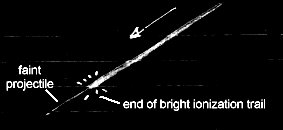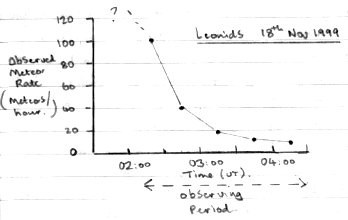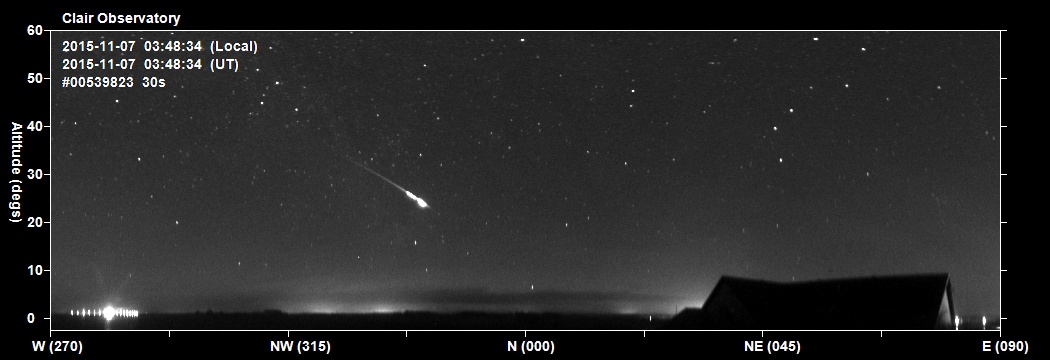David's Astronomy Pages (Solar System)
Meteors
Asteroids
Image
Gallery
Home
Page
Planets
David's Astronomy Pages (Solar System)
|
Asteroids |
Image Gallery |
Home Page |
Planets |

Meteors This page summarises observations and images of meteors.
- Perseid Meteors (1995-Aug-12) - Leonid Meteors (1998-Nov-17) - Leonid Meteors (1999-Nov-17/18) - Geminid Meteors (1999-Dec-12) - Quadrantid Meteors (2000-Jan-3/4) - Leonid Meteors (2000-Nov-17)
Meteors don't require any special equipment to view, just your eyes and some
knowledge about when and where to look. Meteor shower events, of which there are
a number throughout the year are the times when it is most likely that a meteor,
or shooting star can be seen.
One or two meteors are often seen during the course of a sky observing session, when not looking through the telescope's eyepiece. During particularly strong meteor showers up to around 100 meteors can be seen in a single hour if you're lucky.
I've recorded meteor shower observations for 3 events, Perseids 1995, Leonids 1998 and Leonids 1999.
Back to Top
1995-Aug-12, 23:00-23:35 UT. Observing from garden in Westhill, Aberdeen, saw 7 Perseid meteors in 35 minutes of observing (~14 meteors/hour). Included one particularly bright meteor which left a brief 'smoke' trail.
Back to Top
1998-Nov-16, 23:45-24:00 UT. Observing from garden in Westhill, Aberdeen saw 8 leonid meteors in 15-20 minutes of observing, including two excellent bright meteors which approached very fast from the east to end directly overhead, "close enough that you could see the sparks !" as my observing diary states.
1998-Nov-17, 05:20-05:50 UT. Drove to dark sight just beyond Westhill, Aberdeenwith full view of sky. Observed for 30 minutes during which time I saw around 80 Leonid meteors including a high proportion of fireballs (Mag -5 to -10). Peak rates where up to 4 or 5 meteors each minute (equivalent to 200-300 per hour). Meteors where all moving very fast. I had a fantastic view of them. Some of the fireballs were exceptionally bright, and momentarily lit up the sky and the ground, even when looking in completely the opposite direction The number of dim meteors were relatively few. It was clear to me that this was something exceptional and was some 11-12 hours ahead of the predicted peak. (due at 19:00 UT). Quite a few of the meteors where clearly a very long way in the distance, being low down near the horizon and only visable because of their exceptional fireball brightness. The brighter meteors had smoke trails, which lasted at least 2-3 minutes. Several of the meteors appeared to explode with faint projectile appearing to extend beyond the end of the bright ionization trail (see picture below). A thin crescent of the Old Moon was observable at dawn with very distinct earthshine.

Leonid Fireball, emitting faint projectile
beyond 'explosion' point
Inverted
from original sketch
1998-Nov-17, 23:45-24:00 UT. Observing from own garden in Westhill, Aberdeen I saw 4 leonid meteors in 15 minutes of observing (3 dim, only 1 bright).
1998-Nov-18, 05:00-05:30 UT. Drove to dark sight just beyond Westhill, Aberdeen with full view of sky. Observed for 30 minutes during which time I saw around 24 leonid meteors (c.50 per hour), nearly all of which were relatively dim - no fireballs - a distinct contrast to the previous morning, 1998-Nov-17.
Back to Top
1999-Nov-17, 03:40-04:15 UT. Saw no meteors in 32 minutes of net observing time. Limiting magnitude +4.0
1999-Nov-17, 05:35-05:40 UT. Saw one leonid meteor and one sporadic meteor in 5 minutes of observing. Limiting magnitude +3.5
Night of 1999-Nov-17/18 (the big night !) - unfortunately rather spoilt by shower clouds (snow) and cold temperatures. Total cloud at 1999-Nov-17, 23:00 UT and at 1999-Nov-18, 00:40 UT. Began observing at (1999-Nov-18) 02.10 for 3 minutes and then from 02:27 onwards to 04:30 UT with occasional breaks due to snow or passing cloud banks. Limiting Magnitude varying between +4.5 down to +1.0 or lower, cloud cover 20% - 80%+. Observed a total of 39 leonid meteors + 2 sporadics in 85 minutes of net observing time, rates where highest between 02:10 and 2:30 UT and then progressively dropped off. My data is consistent with a Leonid peak happening at or before 2:10 UT (internet reports talk about a peak at around 2.00 UT, ie close to the predicted peak). No fireballs were seen (compare with Leonids 1998), the brightest meteor was about magnitude -3.
| 1999-Nov-18, 02:10-02:30 UT | 10 leonids in | 6 minutes observing | (~100 meteors/hour) | |
| 1999-Nov-18, 02:30-03:00 UT | 16 leonids in | 24 minutes observing | (~ 40 meteors/hour) | |
| 1999-Nov-18, 03:00-03:30 UT | 8 leonids in | 27 minutes observing | (~ 19 meteors/hour) | |
| 1999-Nov-18, 03:30-04:00 UT | 1 leonid in | 5 minutes observing | (~ 12 meteors/hour) | |
| 1999-Nov-18, 04:00-04:30 UT | 4 leonids in | 25 minutes observing | (~ 9 meteors/hour) |
 Leonid Apparent Rates - 1999-Nov-18 |
Back to Top
Viewed several geminid meteors on the evening of 1999-Dec-12 between 22:00 and
23:40 UT. Took several wide angle photos in an un successful attempt to capture
one of them on film.
(The Geminids peak around Dec-13/14 each year)
Back to Top
During a asteroid photograph hunt on 2000-Jan-03/04 (see Asteroid and Other Images 2000-Jan-03/04), I noticed several quadrantid meteors whilst watching the sky during photo exposures. 10 meteors were seen in the period 21:15 UT 3 Jan 00 and 00:40 UT 4 Jan 00, equivalent to a minimum of 3 meteors/hour. (limiting magnitude around 5)
On the following evening under similar observing conditions no meteors were seen during 2 hour period between 2000-Jan-04, 23:00 UT and 2000-Jan-05, 01:00 UT, placing some constraint on the timing of peak activity.
Back to Top
2000-Nov-17 . Generally cloudy. Saw 3 meteors before totally clouded over.
Back to Top
| Panoramic View - Northern Sky |
| Meteor - 2015-11-07 03:48h UT/GMT. Image #539823 |
 |
| Panorama views converted from original fish eye images 30s exposures taken with Oculus All Sky Camera |
Back to Top
| This Web Page: | Meteors |
| Last Updated : | 2015-11-08 |
| Site Owner : | David Richards |
| Home Page : | David's Astronomy Web Site |